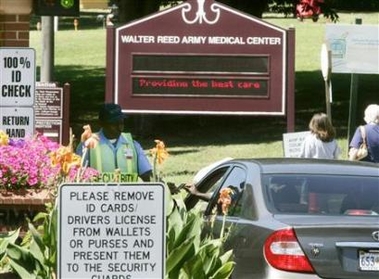Complaining five years later is too G** D*** Late

Today's Examiner has a screaming cover headline about the impact of the military Base Reconsolidation and Closure process. The story, "Region braces for traffic 'chaos'," is about how the movement of close-in, transit-connected facilities, to farther out places lacking high quality transit connections is going to cause problems for commuters.
I wrote that 5 years ago, well, less 6 weeks, when the announcements were first made. Too bad the various newspapers (I think back then the Examiner was still the Journal Newspapers) and politicians didn't think about that then...
Friday, August 26, 2005
Military base relocation
 Security personnel checks vehicles entering Walter Reed Army Medical Center in Washington August 25, 2005. A military panel voted on Thursday to close the Walter Reed Army Medical Center, which has treated U.S. presidents and soldiers including Iraq-war casualties over nearly a century in the U.S. capital. (Larry Downing/Reuters)
Security personnel checks vehicles entering Walter Reed Army Medical Center in Washington August 25, 2005. A military panel voted on Thursday to close the Walter Reed Army Medical Center, which has treated U.S. presidents and soldiers including Iraq-war casualties over nearly a century in the U.S. capital. (Larry Downing/Reuters)Today's papers report on the BRAC decisions with regard to various military installations in the Washington region as well as the broader region including "out-state" Maryland and Virginia. Stephen Pearlstein's column "Base Closings are an open door," argues that these moves will help broaden the business mix and lead to longer term health of the local economy by not being so reliant on the military. (This is also discussed in "TRANSFORMING DC'S OUTDATED MILITARY FACILITIES INTO CITY REVENUES" from the NARPAC website.)
More generally, the State of Maryland is a big winner in this process, as the Baltimore Sun reports in "Panel vote would bring over 7,000 jobs to Md.: Base closing, realignment boosts Fort Meade, Aberdeen Proving Ground; State could end up with largest net gain in jobs."
My concerns center around the sprawl-promoting aspects of the move. Making Fort Belvoir a bigger regional military center increases car trips because it's not well connected to the current transportation infrastruture. And proposals to extend Metro to Fort Belvoir and even to Fort Meade in Maryland (suggested by state officials in Maryland) will add to the transportation infrastructure, but in a way that makes the newly connected area more likely to be developed in traditional sprawling patterns.
As far as Walter Reed goes, people are probably right that if the District can get control of this property (a very long process as pointed out by Delegate Norton) there will be a long-term net gain to the city as it is likely that most of the people working at Walter Reed are suburban residents.
In the old days, when people walked or took streetcars to work, most people lived relatively close to work. For example, perusing Census enumeration sheets for the H Street neighborhood for the early part of the last century finds that hundreds of people work for the Government Printing Office, located a short distance away at North Capitol and H Street, or the Bureau of Engraving and Printing, which spun off the GPO, or at private printers that grew up in the area as a cluster of printing skills developed (e.g, the headquarters of XM Satellite Radio was once a printing plant). Today, if a handful of GPO workers live in Greater Capitol Hill, I would be very surprised.
Labels: intensification of land use, sprawl, sustainable land use and resource planning, transportation planning



1 Comments:
Great information. This works great for me. Thanks for sharing this.
Post a Comment
<< Home